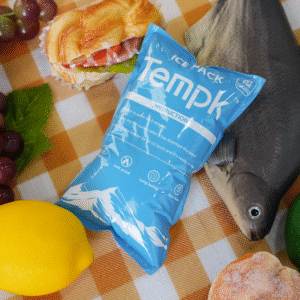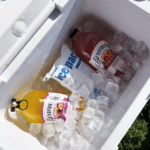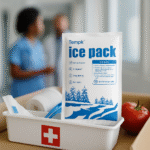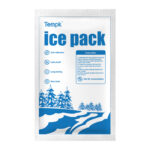Paquetes de hielo seco para el envío: How to Safely Transport Temperature-Sensitive Goods
Shipping temperature-sensitive goods requires a reliable cooling method to preserve product integrity. Dry ice packs have long been the solution to maintain frozen or chilled temperatures during transit. Si enviando comida, productos farmaceuticos, u otros bienes perecederos, dry ice plays a crucial role in ensuring that products stay at the correct temperature. This guide explores the benefits, uso, and safety considerations when shipping with dry ice, along with innovations in the field.
-
Why are dry ice packs necessary for shipping bienes perecederos?
-
How do dry ice packs keep goods at the ideal temperature?
-
What best practices should you follow for safe and effective dry ice shipping?
-
What safety measures must be considered when using dry ice?
Why Are Dry Ice Packs Necessary for Shipping?
Dry ice is essential for keeping perishable goods at the desired temperature. El hielo seco es dióxido de carbono sólido (Co₂), which sublimates directly from a solid to a gas at -78.5°C (-109.3°F). This ultra-low temperature makes dry ice ideal for maintaining frozen conditions during shipments, especially for products like vaccines, mariscos, y muestras biológicas.
Benefits of Dry Ice for Shipping:
-
Control de temperatura: Dry ice maintains freezing conditions during transit.
-
Sin residuo: A diferencia del hielo normal, El hielo seco no se derrite en el agua, which prevents moisture damage to products.
-
De larga duración: El hielo seco dura más que el hielo tradicional, making it perfect for extended shipping durations.
| Característica | Descripción | Por que importa |
|---|---|---|
| Rango de temperatura | -78.5°C | Keeps items frozen or chilled |
| Tasa de sublimación | 5-10 lbs every 24 horas | Determines the amount of dry ice needed |
| Regulaciones de envío | Subject to DOT and IATA rules | Ensures compliance to avoid delays |
Ejemplo:
A pharmaceutical company reported that using dry ice packs helped their medical supplies maintain the required temperature for over 48 horas, Reducir el deterioro de 15%.
How Do Dry Ice Packs Work to Keep Goods at the Right Temperature?
Dry ice works by sublimating and absorbing heat. This cooling effect keeps temperature-sensitive items, like vaccines or frozen foods, at the desired temperature during shipping. The dry ice sublimates (se convierte en gas), which continuously lowers the temperature inside the container, preventing the goods from warming up.
Características clave de las paquetes de hielo seco:
-
Sublimación: Dry ice sublimates steadily at a rate of 5-10 libra cada 24 horas.
-
No Water: Mientras el hielo seco se sublima, it turns into gas, leaving no water to cause leaks or spoilage.
-
Enfriamiento a largo plazo: Dry ice can provide cooling for 24-72 horas, depending on shipment size and insulation.
Ejemplo:
For a 24-hour shipment of meat or seafood, one 10-pound dry ice pack is usually sufficient. Para envíos más largos, multiple packs or larger quantities are needed.
Las mejores prácticas para usar hielo seco en el envío
Para garantizar un rendimiento óptimo, follow these best practices when shipping with dry ice:
-
Use contenedores aislados: Pair dry ice with high-quality insulation to extend its cooling effect. Insulated containers help retain the cooling power of dry ice.
-
Calculate the Right Amount: Usar 5-10 pounds of dry ice per 24-hour shipment for every 10-15 pounds of product. Adjust based on the shipment duration.
-
Asegurar la ventilación adecuada: El hielo seco se sublima en gas dióxido de carbono, so always use well-ventilated containers to avoid pressure build-up.
| Recommended Action | Why It’s Important |
|---|---|
| Use contenedores aislados | Keeps products at the correct temperature for longer periods |
| Calculate the Correct Amount | Prevents overuse or underuse of dry ice |
| Asegurar la ventilación | Prevents dangerous CO₂ gas build-up |
Consejo práctico:
For shipping frozen foods, consider using foam-insulated containers to extend shelf life by up to 50% when paired with dry ice.
Safety When Handling and Shipping Dry Ice
Handling dry ice requires careful safety measures. Its extremely low temperature can cause severe frostbite, and the sublimation of carbon dioxide gas can pose a suffocation risk if containers are not properly ventilated.
Pautas de seguridad clave:
-
Usar equipo de protección: Always use gloves and goggles when handling dry ice to prevent frostbite and injury.
-
Etiquetado adecuado: Mark shipments containing dry ice with appropriate hazard labels to notify handlers.
-
Asegurar la ventilación: Never seal containers containing dry ice. Allow CO₂ gas to escape to avoid rupture.
| Safety Measure | Recommended Action | Why It’s Important |
|---|---|---|
| Usar equipo de protección | Use gloves and goggles | Prevents frostbite and injuries |
| Label Containers | Clearly mark packages with “Dry Ice” | Alerts handlers to potential risks |
| Asegurar la ventilación | Use vented packaging | Prevents CO₂ gas build-up |
Safety Scenario:
A food distributor avoided safety issues by using well-ventilated shipping containers and training staff on proper dry ice handling.
2025 Trends and Developments in Dry Ice Shipping
The dry ice shipping industry continues to evolve. En 2025, new innovations are improving temperature control, seguridad, and logistics efficiency.
Desarrollos clave:
-
Sensores de temperatura inteligentes: These devices provide real-time alerts on temperature changes during transit, enhancing safety and ensuring the quality of temperature-sensitive goods.
-
Blockchain for Traceability: Blockchain technology is being integrated into cold chain logistics, providing transparent tracking of shipments and ensuring temperature integrity.
-
Materiales de aislamiento avanzado: New lightweight and high-performance insulation materials are reducing dry ice consumption and shipping costs.
Ideas del mercado:
With the rise in demand for frozen foods and pharmaceuticals, dry ice is playing an increasingly crucial role in cold chain logistics. The global market for dry ice is expected to grow substantially by 2025, with dry ice becoming the preferred solution for transporting perishable goods.
Preguntas frecuentes
q: How much dry ice should I use when shipping frozen goods?
For each 24-hour shipment, usar 5-10 pounds of dry ice per 10-15 pounds of product. Adjust the amount based on the shipping duration.
q: ¿Es seguro el hielo seco para el envío??
Sí, dry ice is safe for shipping if handled correctly. Always use well-ventilated containers and follow safety guidelines.
Conclusión y recomendaciones
Dry ice is an indispensable tool for shipping perishable goods. By calculating the right amount of dry ice, ensuring proper packaging and insulation, and following safety regulations, you can ensure that your products stay at the correct temperature and arrive in perfect condition.
Pasos de acción:
-
Calculate the right amount of dry ice based on shipment size and duration.
-
Use insulated containers and ensure proper ventilation.
-
Follow safety guidelines and keep up with 2025 regulaciones.
Acerca de Tempk
Tempk is a trusted leader in cold chain logistics, specializing in providing high-quality dry ice solutions for the shipping industry. Our extensive experience ensures that your perishable goods are kept at the correct temperature throughout transit, ensuring safe and reliable deliveries.
Llamado a la acción:
Contact Tempk today for more information on how our dry ice solutions can streamline your shipping process.
























